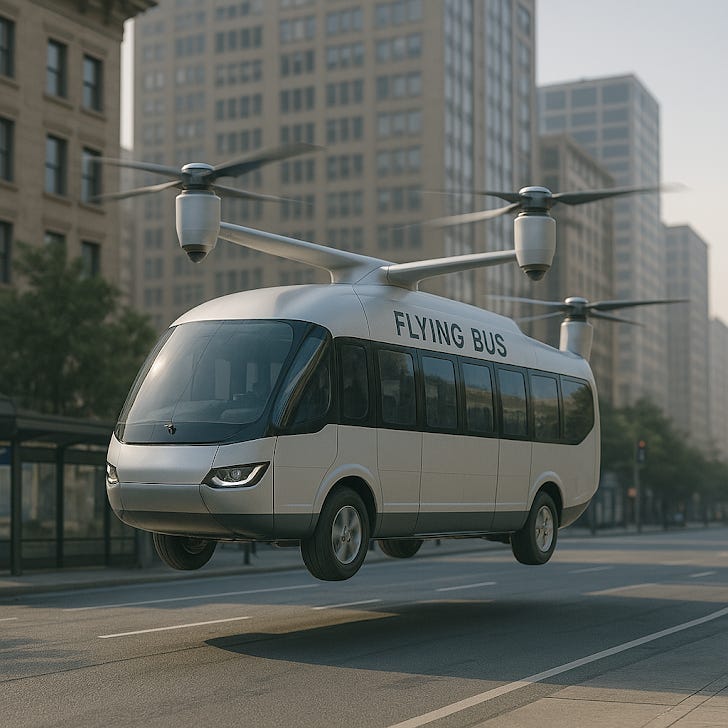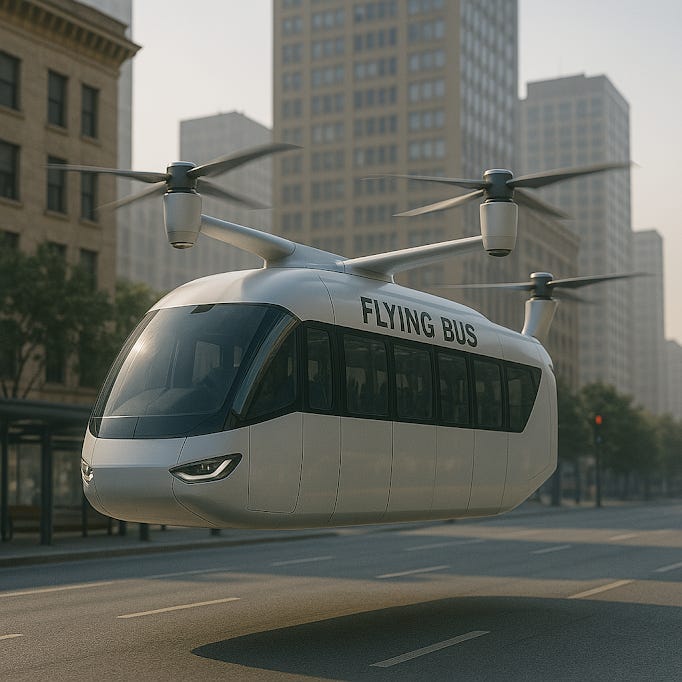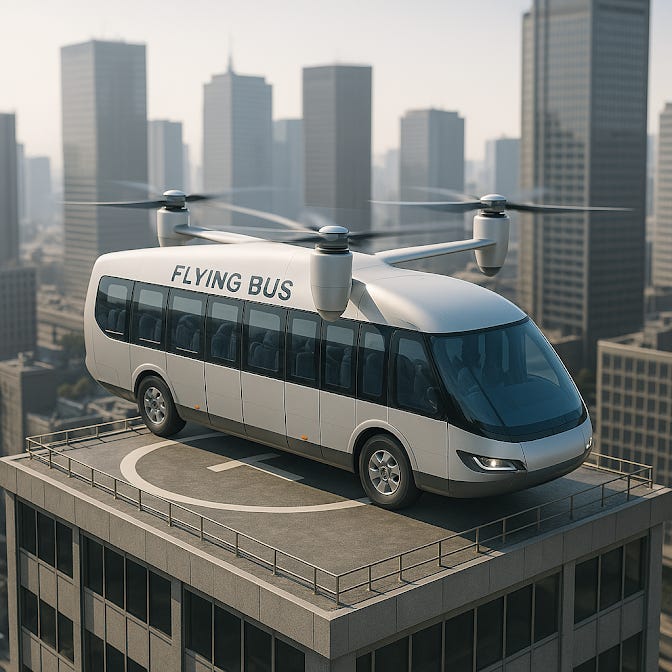Flying Bus
🛸 The Flying Bus: Public Transportation Above the Grid
A new era of clean, silent, and station-to-station flight for people on the move.
Overview
The future of public transportation is taking to the skies. With roads congested, infrastructure aging, and climate concerns rising, cities and remote resorts alike are searching for solutions that go beyond traditional buses, trains, and lifts.
Enter the Flying Bus — an autonomous, electric-powered aerial transit system designed to carry groups of passengers from station to station, bypassing traffic, terrain, and time constraints. Whether in a dense urban skyline or across snowy mountain ranges, the flying bus delivers an elegant solution to the growing need for clean, quiet, and scalable mobility.
What Is a Flying Bus?
A Flying Bus is a large-capacity, vertical takeoff and landing (VTOL) aerial vehicle equipped with autonomous navigation, advanced safety systems, and modular seating. Unlike helicopters or airplanes, the flying bus is designed for frequent, short-range transport, operating like a skyborne metro system — connecting rooftops, transit hubs, ski slopes, or remote villages.
Key Features
🛫 VTOL Operation
Takes off and lands vertically, eliminating the need for runways
Compatible with rooftops, floating pads, and compact urban stations
🧠 Autonomous Navigation
AI-powered route planning and airspace management
Collision avoidance, wind compensation, and real-time rerouting
👥 Group Capacity
Seats between 6–20 passengers per unit
Configurable for standing room or adaptive seating layouts
🔌 Electric & Sustainable
Battery-electric propulsion with optional solar panel assist
Zero local emissions, ultra-quiet ducted fan systems
Fast charging at landing stations or through automated battery swap modules
Applications
🏙️ Urban Commuting
Flying buses reduce road congestion by transporting workers across city sectors via air corridors.
Ideal for business parks, airport transfers, and high-traffic districts.
🏔️ Mountain Resorts & Ski Areas
Replace cable cars and ski lifts with flying buses that deliver skiers from mountaintop to lodge or trailhead.
Operates in all weather, with heated cabins and gear racks.
🌲 Remote Access & Tourism
Bring tourists to remote natural areas or connect rural communities where roads are limited or seasonal.
Can also function as shuttle for eco-lodges and aerial safaris.
🚨 Emergency Transport
Deploy flying buses during disasters to evacuate civilians or transport medical teams and supplies.
Includes modular interior for medivac or field operations.
Advantages Over Ground and Cable Systems
Feature Traditional Bus Cable Lift Flying Bus
Terrain-independent ✖ ✖ ✅
Flexible routing ✖ ✖ ✅
Speed over distance Medium Low High
Peak capacity (per unit) High Medium Medium
Infrastructure required Roads Towers None
Climate impact High (fuel) Medium Low
Safety and Comfort
Redundant rotors and emergency parachute systems
Real-time system diagnostics and predictive maintenance
Soft-suspension landing gear for smooth descents
Climate-controlled cabin and panoramic safety glass
Touchless entry and smart ticketing systems
Stations in the Sky
Flying buses use lightweight floating sky stations or elevated pads on:
Buildings
Mountain peaks
Temporary platforms (events, expeditions)
Each station includes battery recharge/swap tech, AI docking arms, and crowd flow management systems.
Conclusion
The Flying Bus represents a shift in how we move people — not by building more roads, but by opening up the sky. With no dependence on ground infrastructure, no emissions, and near-infinite routing flexibility, this is more than transit.
It’s freedom, elevation, and efficiency for the modern world.
“Why drive around the problem when you can fly right over it?”
Would you like:
A slide deck or pitch presentation version of this article?
A visual mockup or animation storyboard for the Flying Bus in action?
A technical white paper version with specs and design elements?
Let’s get it off the ground.
🛸 Why Flying Buses Make More Sense Than Flying Taxis
The case for licensing aerial mass transit as the future of public transportation
Introduction
The race to unlock the skies is already underway. While much of the hype has centered around flying taxis — small aerial vehicles for individual or dual passenger transport — a more scalable, regulated, and community-centered solution is emerging: the Flying Bus.
Flying buses are mid-sized, autonomous aerial vehicles that carry 6 to 20 passengers along predefined air routes, connecting fixed aerial stations across urban or remote regions. More than a novelty, they represent a realistic and license-friendly alternative to traditional public transportation — and here's why.
1. Easier to License: Like a Cable Car, Not a Car
Flying taxis are extremely difficult to license because they:
Compete directly with private vehicles
Require point-to-point routing flexibility (like Uber but in the air)
Increase risk by operating in unpredictable patterns across crowded zones
In contrast, flying buses:
Follow scheduled routes between predefined air stations, like aerial buses or cable cars
Can be governed under public transport or infrastructure law, not private aviation
Have predictable traffic patterns, making them easier to integrate into airspace regulation systems
This makes it far easier for cities, civil aviation authorities, and ministries of transport to approve aerial bus corridors than swarms of independent flying taxis.
2. Infrastructure-Free — But Still Structured
Flying buses do not require:
Roads
Rails
Cable towers
Heavy underground systems
But they still offer structure: defined pickup/drop-off stations, air routes, and fleet scheduling — like a modernized version of cable cars or buses.
This makes them:
Easier to regulate
Safer to deploy
Scalable for cities, ski resorts, island regions, and more
3. Public Benefit, Not Just Premium Access
Flying taxis are often seen as a luxury product for executives and elites.
Flying buses, by contrast, are:
Accessible to the public
Designed for group transport, like metro or tram systems
Subsidizable by governments as part of modern transit investment
Compatible with smart city infrastructure, multi-modal ticketing, and green urban planning goals
They’re not a toy for the few — they’re a tool for the many.
4. Easier Air Traffic Integration
Flying taxis create dynamic flight paths, requiring:
Real-time air traffic control (ATC) coordination
Complex urban airspace sharing
Greater risk of collision or interference with helicopters, drones, and emergency aircraft
Flying buses, on the other hand:
Operate on predefined, reserved air corridors
Use dedicated sky lanes, similar to buses or trams
Can be managed like scheduled aircraft — far simpler to model, simulate, and monitor
This makes them a better fit for early-stage urban air mobility (UAM) licensing frameworks currently being tested worldwide.
5. Sustainability & Urban Efficiency
Per-passenger emissions are lower than flying taxis
Support shared usage instead of individual vehicle proliferation
Fly above traffic, reducing city congestion without replacing roads
Enable quick deployment in difficult terrain: mountains, islands, deserts, developing areas
They also reduce the burden on ground infrastructure and can be powered by fully electric or hybrid renewable systems.
6. Regulatory Path Already Exists
Many jurisdictions already allow:
Cable cars
Ski lifts
Drones
Helicopter charters
Public aerial transport (trams, gondolas)
Flying buses are technically and legally closer to these systems than to cars or helicopters. This means they:
Can be classified as air-based public transit
Fit into existing frameworks with light modifications
Are more likely to receive public funding, zoning rights, and operator licenses
Conclusion: Why It’s Possible — and Preferable
Flying buses don’t need to wait for a revolution. They fit within regulatory logic, environmental goals, and social expectations today. They avoid the chaos of individual air traffic, reduce infrastructure costs, and bring modern mobility to more people, faster.
The future of transportation is not a million flying taxis…
It’s smart, shared, station-to-station flying buses — designed for people, approved by cities, and scaled to the skies.
Would you like this:
Turned into a public policy brief or white paper?
Illustrated with an airspace diagram of flying bus routes vs. taxi chaos?
Transformed into a video explainer script for public presentations?
Let me know what you'd like next!
Flying Bus Systems: A Scalable, Regulated, and Infrastructure-Free Model for Aerial Public Transportation
Abstract
This technical article outlines the concept and feasibility of Flying Bus Systems (FBS) — mid-capacity, autonomous aerial vehicles designed for structured, station-to-station public transportation. Unlike personal air taxis, flying buses offer greater regulatory compatibility, public utility, and operational efficiency by integrating predefined aerial corridors, standardized landing stations, and embedded safety protocols. The article discusses design architecture, propulsion and navigation systems, regulatory pathways, safety systems (including emergency descent), and environmental impact, establishing the Flying Bus as a near-future solution for both urban and regional mobility challenges.
1. Introduction
The development of aerial mobility has been largely focused on electric vertical takeoff and landing (eVTOL) vehicles designed for individual or dual-occupant air taxi service. While technologically impressive, this model faces substantial barriers: complex routing, high costs, limited airspace availability, and significant regulatory friction.
The Flying Bus presents a technically and logistically superior alternative: a structured, mid-capacity air transit system that operates along fixed aerial corridors, stops at designated elevated stations, and follows predictable flight patterns. This allows for simpler certification, lower operational costs per passenger, and higher throughput than decentralized air taxi models.
2. System Overview
2.1 Definition
A Flying Bus is a large-format aerial vehicle capable of carrying 6–20 passengers per trip. It is powered by electric or hybrid propulsion, operated autonomously or semi-autonomously, and designed to fly short to medium distances (10–50 km) between sky stations — elevated platforms located on rooftops, towers, or hillsides.
2.2 Operating Model
Fixed or semi-fixed flight corridors
Scheduled or on-demand fleet dispatch
Smart docking at aerial terminals
Multi-cabin fleets operating in mesh or ring configurations
3. Vehicle Architecture
3.1 Propulsion
Lift Mechanism: Distributed ducted fans or tilting rotor VTOL system
Cruise Propulsion: Horizontal thrust via electric pusher propellers or rotor tilt
Power System: Lithium-ion battery packs with optional fast-swap modules
Redundancy: Minimum 8-rotor configuration for safe continued operation under partial failure
3.2 Cabin Design
Composite lightweight frame
Reinforced cabin for crash tolerance
Climate control and low-vibration suspension
Modular seating (standing + seated capacity)
Luggage/bike storage or adaptive use cases (ski gear, wheelchairs, etc.)
4. Autonomy and Control Systems
Onboard AI flight control unit with machine learning capabilities
Sensor suite: GNSS, LiDAR, stereo vision, barometric altimeter, IMU
Terrain avoidance and altitude adaptation
Connectivity: 5G/6G, satellite fallback, V2X communications
Ground-based remote oversight in hybrid-autonomous mode
5. Safety Systems
System Description
Collision Avoidance Real-time multi-direction scanning + rerouting
Emergency Parachute Integrated ballistic recovery chute (urban-safe)
Power Redundancy Isolated circuits + dual battery systems
Flight Termination Controlled descent or glide to safe zone
Cabin Monitoring Occupant sensors, fire suppression, SOS override
6. Ground & Sky Station Design
6.1 Station Requirements
Small rooftop or hilltop footprint (15–25m diameter)
Load-balancing power station and/or solar charging
Passenger gate system with weight sensors and security screening
Smart beaconing for autonomous alignment and docking
6.2 Integration
Connects to existing public transportation infrastructure (rail, metro, cable cars)
Can be modular or temporary for events, festivals, or disaster zones
Remote-controlled fleet management console for real-time visibility
7. Regulatory Advantages over Air Taxis
Factor Flying Bus Flying Taxi
Flight Path Fixed routes Unpredictable point-to-point
Airspace Integration Simple corridor-based Complex, real-time clearance
Passenger Flow Mass transport Individual/private service
Licensing Category Public transit-compatible Private aviation category
Infrastructure Needs Shared docking stations Decentralized personal landing rights
By aligning closer to light rail, cable systems, or shuttle aircraft in operation, the Flying Bus is more easily licensed and deployed under existing transportation frameworks, particularly in countries with aerial cable car, gondola, or tram precedents.
8. Environmental Impact
Fully electric models produce zero direct emissions
Hybrid variants can offset emissions with passenger load balancing
Acoustic dampening fans reduce urban noise pollution
Enables reduction of ground traffic and urban sprawl effects
Can be combined with smart grid integration for energy-positive operation
9. Deployment Scenarios
9.1 Urban Zones
Connect business districts, airports, stadiums, universities, and hospitals
Operates in parallel to bus/tram networks — as air transit corridors
9.2 Tourism & Remote Access
Replace chairlifts or cable cars at ski resorts or parks
Provide transportation to islands or mountaintop sites
9.3 Emergency & Disaster Relief
Function as mobile evacuation or relief delivery units
Operate without reliance on ground roads or towers
10. Conclusion
The Flying Bus offers a technically viable, economically efficient, and regulatory-ready path to scaled aerial public transportation. By merging the flexibility of flight with the predictability of buses, and by prioritizing shared, autonomous infrastructure, flying buses are poised to outperform air taxis in safety, cost, and deployability.
They represent not just the future of flight, but the future of accessible, clean, and inclusive transit — not for the few, but for the many.



